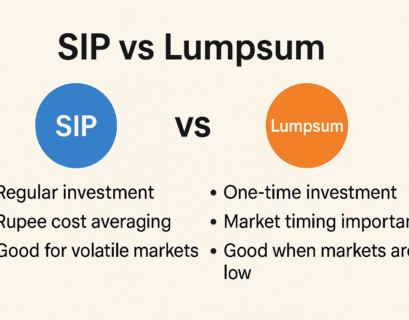Introduction
Investing in mutual funds can be a great way to grow your wealth over time. With the variety of mutual funds available in India, it can be challenging to determine which one is right for you. Here’s a brief guide on some of the most popular types of mutual funds you can invest in:
1. Large-Cap Funds
Large-cap funds invest in companies with large market capitalizations, typically the top 100 companies in terms of market value. These companies are usually well-established with a stable performance record. Investing in large-cap funds is considered relatively safer and provides steady returns over the long term.
Advantages:
- Lower risk due to investment in stable companies.
- Potential for steady returns.
- High liquidity due to investment in well-established companies.
Disadvantages:
- Limited growth potential compared to mid-cap or small-cap funds.
2. Mid-Cap Funds
Mid-cap funds invest in medium-sized companies, typically ranked between 101 and 250 in market capitalization. These funds offer a balance between the stability of large-cap funds and the growth potential of small-cap funds.
Advantages:
- Higher growth potential than large-cap funds.
- Diversification across various sectors.
Disadvantages:
- Higher risk compared to large-cap funds.
- Can be more volatile in the short term.
3. Small-Cap Funds
Small-cap funds invest in smaller companies with high growth potential. These funds are suitable for investors with a high-risk tolerance and a long-term investment horizon.
Advantages:
- Significant growth potential.
- Opportunity to invest in emerging companies.
Disadvantages:
- High risk and volatility.
- Less liquidity compared to large and mid-cap funds.
4. Flexi-Cap Funds
Flexi-cap funds have the flexibility to invest across companies of all market capitalizations—large, mid, and small caps. This allows fund managers to adjust the portfolio based on market conditions and opportunities.
Advantages:
- Flexibility to adapt to market conditions.
- Balanced risk and return profile.
Disadvantages:
- Performance depends heavily on the fund manager’s decisions.
5. Thematic/Sectoral Funds
Thematic or sectoral funds invest in specific sectors or themes, such as technology, healthcare, or energy. These funds are suitable for investors who have a strong belief in the growth potential of a particular sector.
Advantages:
- High potential for returns if the sector performs well.
- Focused investment strategy.
Disadvantages:
- High risk due to lack of diversification.
- Performance is highly dependent on the chosen sector.
6. Equity Linked Savings Scheme (ELSS)
Equity Linked Savings Schemes (ELSS) are mutual funds that offer tax benefits under Section 80C of the Income Tax Act. These funds primarily invest in equities and have a mandatory lock-in period of three years.
Advantages:
- Tax benefits up to ₹1.5 lakh under Section 80C.
- Potential for high returns due to equity investments.
- Short lock-in period compared to other tax-saving instruments.
Disadvantages:
- High risk due to exposure to equities.
- Returns are not guaranteed and depend on market performance.
7. Multi Cap Fund
Multi cap funds invest across companies of various market capitalizations—large, mid, and small caps. This diversification helps in balancing the risk and reward ratio, allowing fund managers to capitalize on opportunities across the market spectrum.
Advantages:
- Diversification across market capitalizations.
- Flexibility to adapt to changing market conditions.
- Balanced risk and return profile.
Disadvantages:
- Moderate risk, as exposure to small caps can increase volatility.
- Performance relies on the fund manager’s ability to choose the right mix.
8. Value Fund/Contra Fund
Value funds invest in undervalued stocks that have the potential for significant appreciation over time. Contra funds follow a contrarian investment strategy, investing in stocks that are currently out of favor but have strong fundamentals.
Advantages:
- Opportunity to invest in undervalued stocks.
- Potential for high returns as market sentiment changes.
- Diversification through a contrarian approach.
Disadvantages:
- Requires a long-term investment horizon.
- Higher risk as the strategy may take time to yield results.
9. Focused Fund
Focused funds concentrate their investments in a limited number of stocks, usually around 20-30. This allows fund managers to thoroughly research and invest in companies they believe will perform well.
Advantages:
- Potential for high returns through concentrated investments.
- In-depth research and analysis of selected stocks.
- Simplified portfolio management.
Disadvantages:
- Higher risk due to limited diversification.
- Performance heavily depends on the chosen stocks.
10. Dividend Yield Fund
Dividend yield funds invest in companies that regularly pay high dividends. These funds are suitable for investors seeking regular income along with capital appreciation.
Advantages:
- Regular income through dividends.
- Potential for capital appreciation.
- Lower risk as dividend-paying companies are usually stable.
Disadvantages:
- Limited growth potential compared to growth-oriented funds.
- Dividend payouts are not guaranteed and can vary.
11. Large and Mid-Cap Funds
Large and mid-cap funds invest in a mix of large-cap and mid-cap companies, providing a balanced approach to investing. These funds aim to capture the stability of large-cap stocks while benefiting from the growth potential of mid-cap stocks.
Advantages:
- Balanced risk due to diversification across large and mid-cap companies.
- Potential for higher returns compared to pure large-cap funds.
- Stability from large-cap investments combined with growth from mid-cap investments.
Disadvantages:
- Moderate risk as mid-cap stocks can be more volatile.
- Returns depend on the performance of both large and mid-cap segments.
Bottom Line
When choosing a mutual fund, it’s crucial to consider your investment goals, risk tolerance, and investment horizon. Diversifying your investments across different types of funds can help manage risk and maximize returns. Always conduct thorough research or consult with a financial advisor before making investment decisions.
By understanding the different types of mutual funds available in India, you can make more informed choices and build a robust investment portfolio. Happy investing!
Also Read: Understanding Futures and Options: A Brief Guide For Beginners
Disclaimer:
CurrencyVeda provides this news article for informational purposes only. We do not offer investment advice or recommendations. Before making any investment decisions, please conduct thorough research, consult with financial experts, and carefully consider your financial situation, risk tolerance, and investment goals. Investing in the stock market carries risks, and it’s essential to make informed choices based on your individual circumstances. CurrencyVeda is not liable for any actions taken based on the information provided in this article.





